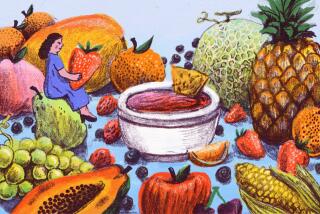Eating Smart : Unusual, and Nutritious, Produce With Familiar Flavors
- Share via
Food markets both large and small have access to a staggering array of fabulous fruits and vegetables.
Some of the most interesting fruits, however, are ones that you may never have heard of and might not even recognize if you saw them. We thought we’d list some of these wonderful treats in case you feel adventuresome and decide to check out your store for some unusual produce.
* Atemoya. This fruit is a cross between a cherimoya (see below) and a sugar apple. Outside, it looks somewhat like a clay artichoke, which doesn’t sound very appealing, but inside it is the color of cream, and tastes and feels like custard.
Nutritionally, its appeal is its high potassium content. Atemoyas grow in southern Florida and are also shipped in from the West Indies. The peak season is August through October. When you buy these fruits, look for a pale green that yields slightly to pressure from your fingers but has not cracked open. You can keep atemoyas at room temperature for a day or two if they are not already soft when you get them home. Once ripe, they will keep in the refrigerator for a day or two.
Atemoyas taste best when they have been chilled. To serve them, cut the fruit in half through the stem end and scoop out the flesh. They are wonderful additions to a fruit salad but are also sweet enough to eat on their own.
* Carambola. This unusual-looking fruit is also called the star fruit because when you slice it cross-wise, you end up with perfect five-pointed stars. Obviously, it makes a beautiful garnish. In the market, carambolas are oval with very deep ridges going all the way to the center of the fruit. The flavor is kind of sweet-tart, and reminds us more of a blend of fruits like plums, pineapples, grapes and lemons.
Carambolas are available from fall through late winter. You want to look for fruits that are shiny and well-shaped. When they are unripe, the skin is green, but left at room temperature for a few days, they will turn a beautiful gold color and also develop a wonderful aroma.
To use them, slice the fruit, remove the seeds and then use the slices as a garnish or as a dessert topping. We have tried sauteing them with a little white or brown sugar and serving them over low-fat frozen yogurt, and they are delicious.
* Cherimoya. This fruit, which is now grown in California and Florida, is also known as the custard apple or sherbet fruit. It looks very much like a green pine cone, but inside it has a custard-like texture and flavor that makes you think of other tropical fruits.
Cherimoyas are usually available in the winter and early spring. The size doesn’t matter, but look for fruits that are yellow-green all over. You should let them ripen at room temperature until they feel like a ripe peach, and then refrigerate and serve cold. Most people just cut the fruit in half, discard the seeds and spoon it out of the shell. Nutritionally, it is a pretty good source of vitamin C and even has some iron.
* Longan. These fruits are native to Asia and can range in size from that of a grape to a plum. They are related to lychees and are sometimes known as dragon eyes. If you peel one, you’ll know why, but don’t let that stop you.
They start to be available in late summer and are an incredibly good source of vitamin C. Look for fruits that are heavy for their size and have shells without cracks. Most people eat them raw, but they are also wonderful poached in water or wine.
* Pomelo. This is actually a kind of ancient grapefruit. The size of a melon and pear-shaped, it is usually available from late fall through midwinter. It is an excellent source of vitamin C.
Pomelos are pinkish or greenish yellow, and the flesh separates into segments, like grapefruit. They can be very tart or very sweet. Pick fruits that are heavy and fragrant, and store them in the refrigerator.
Be sure not to eat the white pithy material under the skin because it is extremely bitter.
* Sapote (or Sapota). White sapotes are about the size of an orange but have a green to yellow skin. Inside, they are white and creamy. California sapotes are available from late summer to early fall.
Choose firm fruits that can ripen at room temperature for a day or two. Once they get soft, put them in the refrigerator. You can eat them just like you would a plum, but the skin is bitter, so you may want to spoon out the fruit.
A squirt of lemon or lime juice sparks up the flavor.
* Ugli fruit. This is a fairly new citrus fruit that is actually a hybrid of a grapefruit and an orange or a tangerine. It is sweeter than grapefruit and has almost no seeds.
Looking at the skin might give you a clue as to how it got its name. It is thick, rough, puffy and can be a kind of blotchy orange-green. It is usually most plentiful in winter and early spring. Choose a fruit that is heavy but gives in to slight pressure. Eat them the same way you would any citrus fruit.
*
Dr. Sheldon Margen is professor of public health at UC Berkeley; Dale A. Ogar is managing editor of the UC Berkeley Wellness Letter. They are the authors of several books, including “The Wellness Encyclopedia of Food and Nutrition.”
More to Read
Eat your way across L.A.
Get our weekly Tasting Notes newsletter for reviews, news and more.
You may occasionally receive promotional content from the Los Angeles Times.








